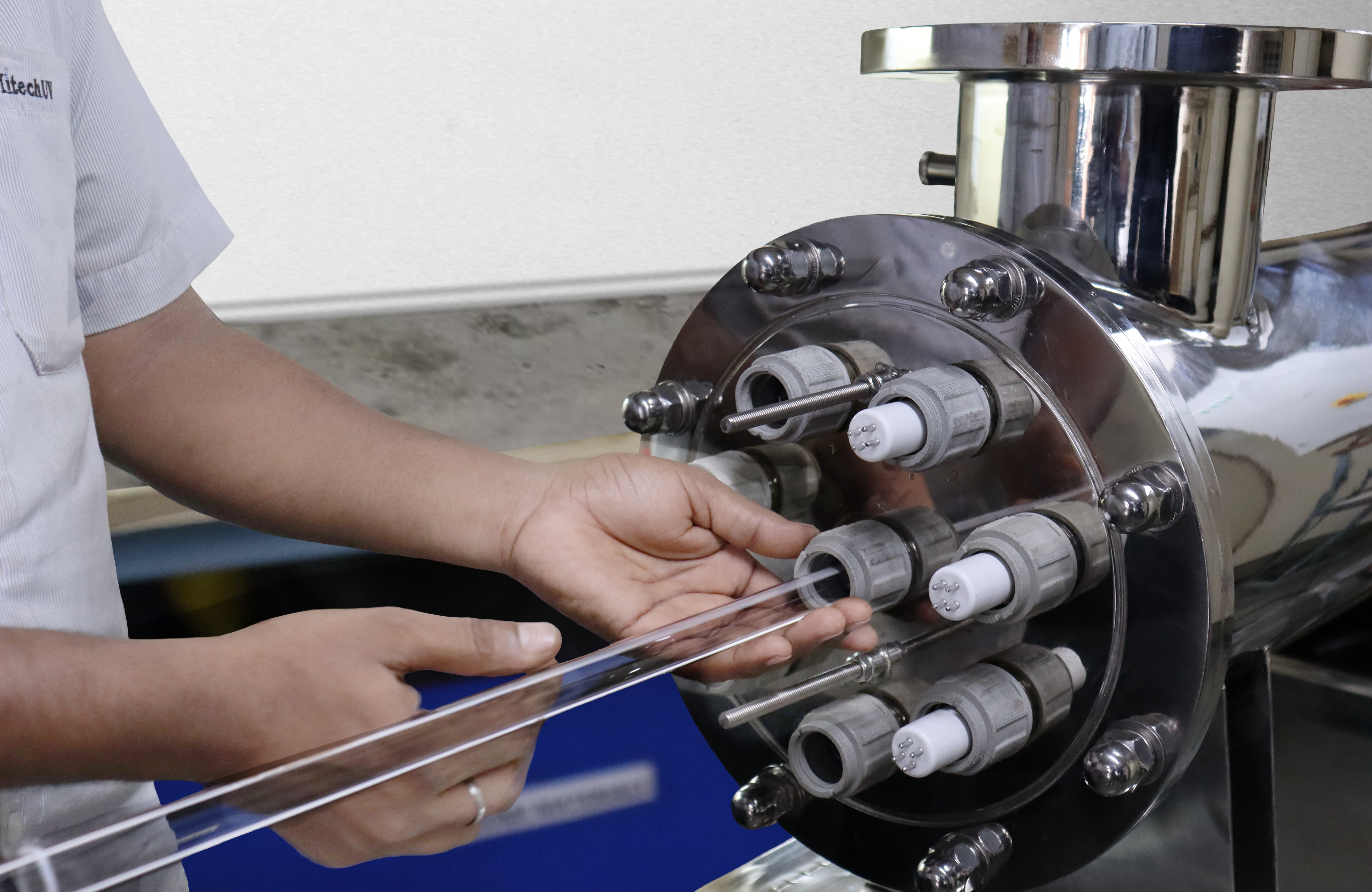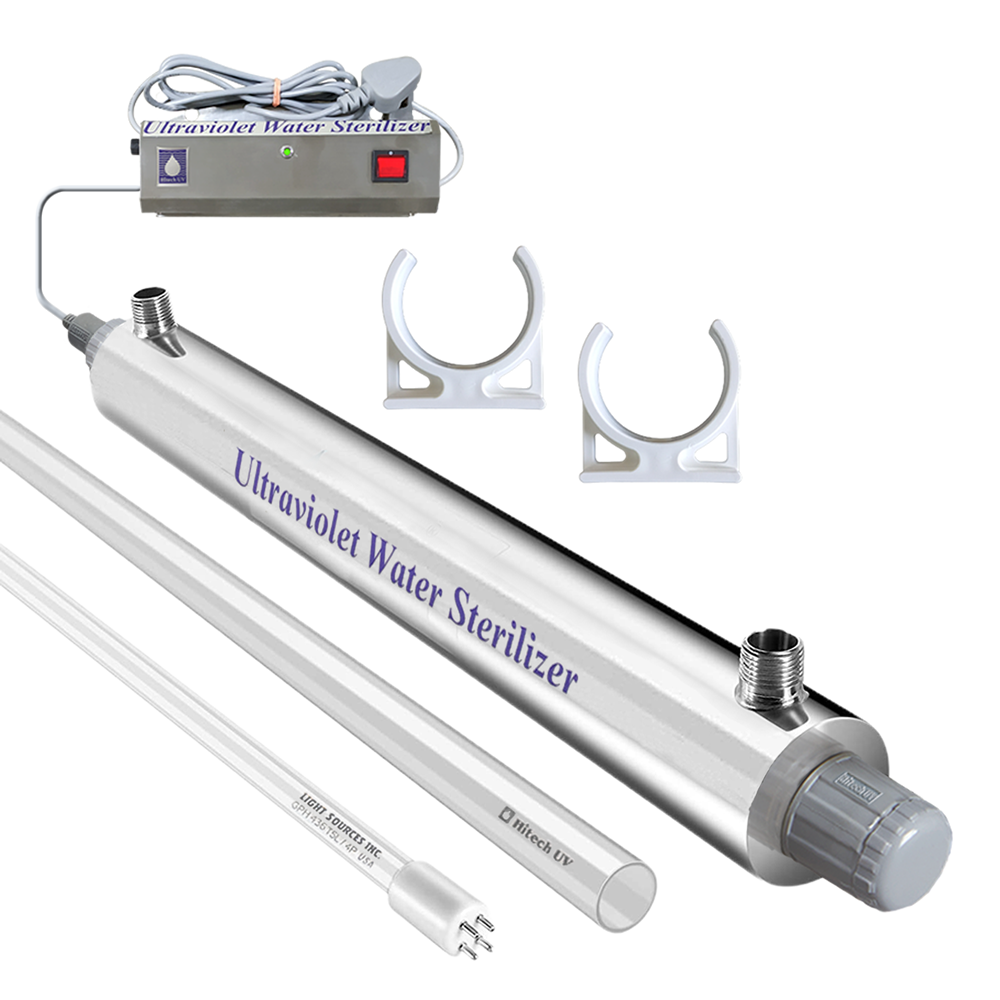UV Disinfection System For Water Treatment

What is UV Water System?
Exposing contaminated water to UV light rays is a reliable method of disinfection that is still used today. Because UV radiation may enter through cell barriers to destroy genetic material and prevent reproduction, the treatment is effective. UV light is produced by a particular lamp by striking an electric arc through low-pressure mercury vapour. With strong peaks at UV wavelengths of 253.7 nanometers (nm) and a less intense peak at 184.9 nm, this lamp generates a wide range of energy. According to research, the best UV wavelength range for killing bacteria is between 250 and 270 nm. Ozone, hydroxyl, and other free radicals produced by UV light at shorter wavelengths (e.g. 185 nm) can kill microorganisms.
How Does UV Water System Work?
For the inactivation of microorganisms in commercial, industrial, and healthcare environments, UV disinfection is a broad-spectrum, non-chemical disinfection technique. Special UV lights produce the disinfecting UV rays. Each lamp has a Quartz tube that is waterproof. Gas plasma created in the lamp emits powerful UV light as it passes through the quartz tubing, illuminating the liquid to be cleaned. Microorganisms' cellular DNA and RNA absorb the germicidal UV light wavelength when it is present, which damages their nucleic acid. The DNA of the bacteria is altered in such a way that it can no longer divide and reproduce, making it dormant. UV quickly renders bacteria, viruses, yeasts, and moulds inactive.
What's inside a UV Water System?
A chamber that houses the complete system is part of a UV water system. The UV lamp, which emits a germicidal wavelength of radiation (UV-C) to render living things inactive, is housed in a glass quartz sleeve. Because the quartz glass sleeve is transparent to UV light, UV light can pass through it and purify the water. The UV lamp is shielded from water by a quartz sleeve because water and electricity don't mix well. One or two O-rings are required to completely seal the mechanism.
Mercury vapour is used to power UV lamps. In the shape of tiny beads, mercury vapour is injected into a UV lamp. Beads may occasionally be seen tumbling about inside the bulb. These beads are mercury that hasn't been evaporated to become lamp fuel.

How long does it take for UV Water System light to sterilize water?
UV radiation is classified into three types: UV-A, UV-B, and UV-C. UV-C photons may efficiently destroy bacteria and viruses because they have the shortest wavelength of the three basic UV wavelengths. Because their narrow wavelength of 200 - 400 nanometers (nm) contains the maximum energy, they can destroy hazardous microorganisms.
People frequently inquire how long it takes UV light to destroy microorganisms. The simple answer is that it takes "minutes to hours" to eliminate or destroy microorganisms from water.
However, several elements such as the energy output of the radiation source, the distance, the wavelength of the radiation, and the exposure period all influence the time. Because electromagnetic radiation obeys the inverse square rule, its intensity decreases in proportion to the square of the distance. The spacing is critical.
To eradicate a virus, extremely high amounts of UV radiation are required. The quantity of UV required and the time necessary are determined by a number of factors, including the form and substance on which the virus is present.
John Hopkins University researchers found that it only takes 15 minutes to use UV radiation to disinfect "high contact" public areas in hospitals, such as bed rails, tray tables, and vitals monitors. It can kill an average bacteria in 10 seconds at a distance of six inches from the American Ultraviolet Germicidal Fixture bulb.
Industrial UV Water Disinfection System Applications
Industrial UV water disinfection systems use high-frequency light in the UV-C band to sterilise large amounts of water.
UV disinfection is a popular method for removing bacteria and other germs from water in industrial water treatment applications. It can also eliminate chlorine, chloramines, ozone, bromine, and other organic impurities without changing the colour, taste, or pH of the water, making it suitable for a variety of disinfection applications.
Some of the Industrial Applications of UV Disinfection System
- Food and beverage industry: UV disinfection systems can help the food and beverage industry achieve FDA-approved water quality.
- Biopharmaceutical: Chlorine, ozone, and pathogens must be removed from pharmaceutical and healthcare water. Most pharmaceutical companies use UV equipment to sterilise their water.
- Cosmetics: Bacteria- and pollutant- free water increases cosmetics' quality and shelf life. UV disinfection is the dominant technology in the cosmetics industry worldwide.
- UV Drinking Water Disinfection: A UV drinking water disinfection system is a simple and low-cost approach to ensure that your home or workplace gets clean water at all times.
- Waste Water Disinfection and Reuse: By treating waste water at the tertiary stage, UV Disinfection can assist address the concerns of water shortages and rising fresh water costs. UV disinfection systems are designed particularly for wastewater disinfection and reuse, allowing it to be reused for flushing and gardening.
- Swimming Pools: Traditionally, chlorine has been used to keep swimming pools clean. Chemical disinfection, on the other hand, appears to stimulate chemical reactions with a wide range of other organic molecules, resulting in the production of hundreds of new, potentially harmful compounds.
UV, a chemical-free form of pool disinfection, is often regarded as a safer and more cost-effective option.
Residential UV Water Disinfection System
Residential UV water disinfection systems use low-frequency light in the UV-C band to sterilise small amounts of water.
Protect your family from hazardous germs with an all-in-one water purification system. This all-in-one water filtration system is suitable for purifying any drinking water that enters your home.
Hitechuv filters water so that it may be safely drank or utilised throughout your house or business. This all-in-one water treatment system combines filtration, adsorption, and UV disinfection — three processes that have been shown to remove sediment, enhance taste, clarity, and odour, and inactivate germs and pathogens in your water. An efficient rainwater purification device that converts collected tank water into safe drinking water. It may also be used to treat bore water and municipal water.
